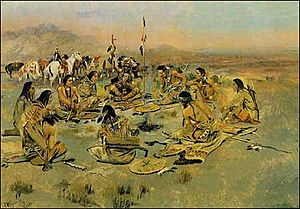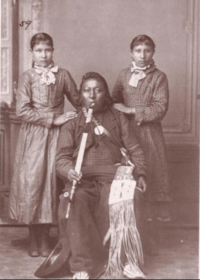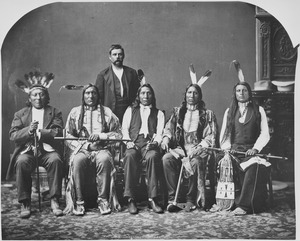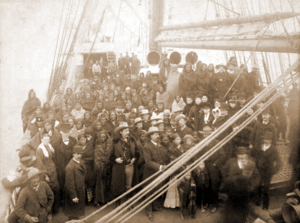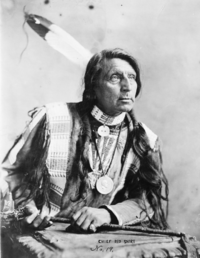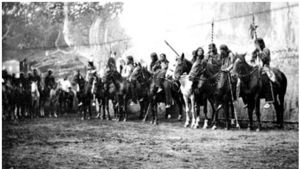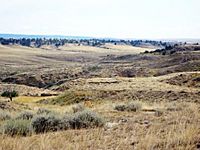Red Shirt (Oglala) facts for kids
Quick facts for kids
Red Shirt
|
|
|---|---|
| Ógle Šá | |
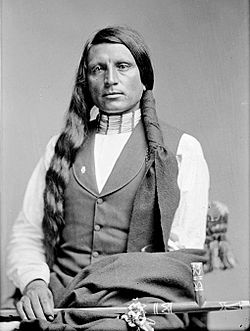
Chief Red Shirt
|
|
| Oglala Lakota leader | |
| Personal details | |
| Born | 1847 near Fort Fetterman, Wyoming |
| Died | January 4, 1925 Pine Ridge Reservation, South Dakota |
| Spouse | Julia In Sight |
| Children | Annie Red Shirt, William Red Shirt, Casey Red Shirt |
| Known for | Oglala chief, warrior and statesman. Served on peace delegations, international celebrity with Buffalo Bill's Wild West. |
Red Shirt (Oglala Lakota: Ógle Šá) (1847 – January 4, 1925) was an Oglala Lakota chief, warrior, and leader. He is known for being a Native Scout for the U.S. Army. Red Shirt also worked to build good relationships with white people. He believed in education for his people.
Red Shirt was a delegate to Washington D.C. in 1880. He was also one of the first Native Americans to join Buffalo Bill's Wild West show. He became famous around the world while touring with the show. His trips to England in 1887 showed Europeans a new, modern image of Native Americans. He also supported the Carlisle Native Industrial School.
Contents
Early Life and Leadership
Red Shirt was born near Fort Fetterman, Wyoming. Some stories say his father was white and his mother was Lakota. Red Shirt himself said his father was a great warrior chief.
Historian Will Rogers said Red Shirt was the son of Red Dog. Red Dog was an important leader of the Oyuhpe band. This group settled at Pine Ridge, South Dakota. Both Red Shirt and Red Dog went to Washington D.C. in 1880. They were Lakota delegates, meaning they represented their people. They also served as police officers on the Pine Ridge Indian Reservation. Both men sent their children to the Carlisle Native Industrial School in Carlisle, Pennsylvania. By 1877, Red Shirt was a recognized leader of the Wagluhe band at Pine Ridge.
U.S. Army Native Scout
Red Shirt became a U.S. Army Native Scout during the Great Sioux War of 1876-77. He worked with the U.S. 4th Cavalry Regiment. During this time, he became a rising leader among the Wagluhe people. The Wagluhe split into three groups, led by American Horse, Blue Horse, and Three Bears. Red Shirt was Three Bears' assistant.
In 1879, Red Shirt officially became a chief at the Pine Ridge Agency. He also became a chief of the Pine Ridge Police. He continued this role until at least 1910. In 1880, Red Shirt traveled to the Carlisle Native School with other leaders like Red Cloud and Red Dog. They then went to Washington D.C. as Lakota representatives.
A Brave Warrior
Many people debate if Red Shirt was part of the Battle of the Little Bighorn. However, his family members have shared stories of his bravery in battle.
Buffalo Bill Cody was very impressed with Red Shirt. Cody said that Red Shirt was a strong warrior. He was second only to Sitting Bull in his influence. Cody told a story about Red Shirt stopping an uprising among his people. Red Shirt went into the leader's camp with only two followers and stopped the trouble. This brave act made his people respect him even more. When Red Shirt decided to join the Wild West show, his influence helped Cody find other Native Americans to join.
Carlisle Native Industrial School
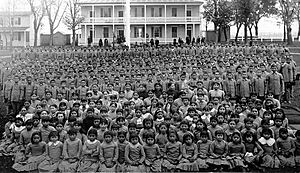
In 1879, Red Shirt, along with Blue Horse and American Horse, sent their children to the first class at the Carlisle Indian Industrial School. They wanted their children to learn English, trade skills, and white customs.
Life at Carlisle was not easy for these first Sioux children. But it was seen as their best chance for a future. Joining the Wild West show and attending the Carlisle Indian School offered education, chances, and hope. This was during a difficult time for the Lakota people. Many Wild West performers from Pine Ridge sent their children to Carlisle from 1879 until it closed in 1918.
Wild Westing
On March 31, 1887, Chief Red Shirt, Chief Blue Horse, and Chief American Horse and their families began a new journey. They boarded the SS State of Nebraska in New York City. They crossed the sea to England with Buffalo Bill's show. This was for his first international tour. They performed at the Golden Jubilee of Queen Victoria. They also toured through Birmingham, Salford, and London for five months.
The group included 97 Native Americans, 18 buffaloes, and many other animals and horses. Buffalo Bill treated his Native American performers fairly. They received good pay, travel, housing, plenty of food, and gifts. The men had money for themselves and their families back on the reservation. Women performers were paid extra for infants and children. They also earned money by making and selling Lakota crafts. Older Native men were hired to appear in parades. They helped make sure the young men acted politely when visiting towns. Traditional Oglala Lakota chiefs and former U.S. Army Native Scouts helped keep order.
Oglala Wild West performers called themselves "Oskate Wicasa" or "Show Man." This was a title of great honor. Since 1887, performing in Wild West shows has been a family tradition for many Pine Ridge families.
Crossing the Sea
Before the trip to England in 1887, some Native Americans were afraid of crossing the ocean. Red Shirt explained that many tribes believed that if a Native American tried to cross the ocean, they would get sick.
The day after leaving New York, many of the Native Americans started to feel seasick. Their fears grew stronger. Even Red Shirt, who was very brave, began to worry. Buffalo Bill tried his best to cheer them up. For two days, almost everyone was too sick to do anything but feed the fish. On the third day, everyone started to feel better. Buffalo Bill gathered the Native Americans in the main room and gave a speech. Red Shirt, who was no longer worried, also spoke.
Red Shirt in England
Chief Red Shirt was very popular with the British newspapers. Reporters took his picture everywhere he went. His good looks and dignified manner made reporters want to hear what he said. He became the most quoted celebrity from Cody's trip to England.
Red Shirt told a reporter from Sheffield: "I left my home two months ago knowing nothing. If I had stayed on the Native Reservations, I would have been like a blind man. Now I can see a new dawn. I have seen the great houses (ships) that cross the mighty waters. I have seen the great villages that never end, where white people are like insects in the summer sun. Our people will be amazed when we return to the Native Reservation and tell them what we have seen."
A Statesman
Red Shirt acted like a true statesman during his time with the show. He presented an image of Native Americans that Europeans saw as noble and civilized. Queen Victoria admired Chief Red Shirt. She even asked for a special performance just for her. Red Shirt spoke to The Brisbane Courier about the future of Native Americans in the United States.
Important Visitors at Earl’s Court

After a performance, the royal family visited the Native American camp. Prince Albert Edward had a long talk with Red Shirt. Princess Alexandra, through an interpreter, welcomed Chief Red Shirt and other Wild West performers to England. The chief, with great dignity, replied: "Tell the Great White Chief's wife that it makes my heart glad to hear her words."
On April 28, 1887, William Ewart Gladstone visited the Wild West show. He was a former Prime Minister and a leader in Parliament. He and his wife toured the grounds at Earl's Court and spoke with Red Shirt for a long time. Red Shirt was very impressed with Gladstone.
Red Shirt said about Gladstone: "When I saw the great White Chief I thought he was a great man. When I heard him speak, then I felt sure he was a great man. But the White Chief is not like the big men in our tribes. He wore no feathers or decorations. He had none of his young men (warriors) with him. If I had not heard him talk, he would have seemed like any other white man to me. But my brother Mr. Gladstone came to see me in my lodge as a friend. I was glad to see the White Chief. Even though my tongue was tied in his presence, my heart was full of friendship. After he left, they told me that half of his great nation of white men have chosen him as their chief. If he were not both good and wise, so many young men of his nation would never have chosen him as their leader."
Meeting Queen Victoria
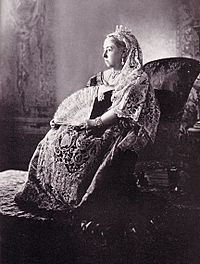
On May 9, 1887, Buffalo Bill's Wild West show opened in London. Queen Victoria was in the audience. Three days later, she visited the camp at Earl's Court. Black Elk remembered that the Native Americans were told "that Majesty was coming." Red Shirt told the Queen he was happy to meet her. He said, "I have come many thousands of miles to see you. Now that I have seen you, my heart is glad." This meeting and his words were widely shared by the press. The Queen also wrote about it in her diary.
The Queen had been very private since her husband, Prince Albert, died thirty years earlier. She rarely appeared in public. She never went to plays during her time of mourning. If she wanted to see actors, they would perform privately at her court. But the Wild West show was too big to bring to Windsor Castle. So, the Queen had to go to the show if she wanted to see it.
Cody presented Red Shirt, who was dressed in war paint and feathers. His proud manner impressed the royal family. When he spoke through an interpreter, saying he had come a long way to see her and "felt glad," the Queen smiled. Cody said that Red Shirt walked away with the dignity of a judge. The Queen seemed to think, "I know a real prince when I see him." The show was a great success. Cody thanked the audience, and they cheered for him and Red Shirt.
Goethe's Faust
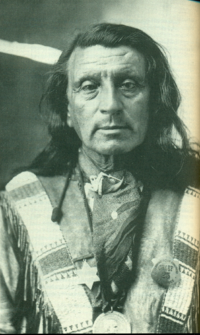
Soon after arriving in London, Cody took some of his Wild West performers to see a play. It was Sir Henry Irving's production of Goethe's Faust at the Lyceum Theater. The London Times reported that the Sioux were very scared by the horror in the play. Red Shirt, called the "Chief of the Show Natives" by the press, sat in the royal box. This made the cowboys and Native Americans seem very important.
Irving used the chance to his advantage. He invited the performers onto the stage after the show. Red Shirt said the show reminded him of a dream. The Sioux did not believe in a hell. So, their interpreter said they saw the scary scenes of Hades as "a Wasichu’s (white man's) dream."
A Vision at Westminster Abbey
Red Shirt shared his thoughts on the grand buildings in England: "The white man’s lodges for the Great Spirit, whose tops reach the sky, and which have stood for more seasons than the red man can count, all filled me with great wonder. And the Great Spirit speaks to me sometimes since I have been here. When I was in the Great Spirit Lodge (Westminster Abbey) where the kings are buried, I put my face in my hands. I did not understand the preacher's words, but they sounded like soft winds through a forest. My eyelids felt heavy. Then I heard soft music and sweet voices. A great cloud came down towards me. When it almost touched me, it opened. I saw in a bright light girls with wings, and they called to me. I was so sure that what I saw was real that I called out to my young men who were with me, ‘Come and see what this is!’ But the young men replied, ‘You have been dreaming.’ But what I saw was true. When I looked around the great lodge afterward, I saw the same girls with wings on the walls as I saw in my dreams. Our people will be amazed by these things when we return to the Native Reservation and tell them what we have seen."
English Hospitality
The London Courier reported that Red Shirt and his friends enjoyed an evening of English hospitality. On a Sunday, the Native American group from Buffalo Bill's Wild West Show visited Willesden. Mr. T.B. Jones, who owned the White Hart Hotel, invited Red Shirt, Blue Horse, Little Bull, Little Chief, Flies Above, and about twenty others for an outing. They enjoyed his generous hospitality.
These famous chiefs and their companions traveled in carriages. Their faces were painted brightly. They wore feathers and ornaments. They were dressed in their colorful clothes. Their chief interpreter, Broncho Bill, and other officials joined them. They arrived at the White Hart around 12:30 p.m.
Surrounded By the Enemy's Funeral
In 1887, Buffalo Bill and his Wild West show stayed in the City of Salford, England, for five months. While there, a stuntman named Surrounded By the Enemy died. He was a gun-slinging and horse-riding performer. He likely died from a chest infection caused by the cold weather. Surrounded was described as a tall, impressive Sioux warrior, 22 years old.
There is no record of a church burial for him. It is believed that Red Shirt and Black Elk led a traditional Sioux ceremony for his burial. The connection between the Oglala Lakota and Salford lives on. There are street names like Buffalo Court and Dakota Avenue in the city.
Eiffel Tower
In 1889, Cody's Wild West show spent six months in Paris. On the 100th anniversary of the fall of the Bastille, some Wild West performers went up the Eiffel Tower. From the top, Red Shirt looked down at Paris and up at the sky. He said, "If people look so little to us up here, how much smaller they must seem to One "Wakantanka" (Great Spirit) who is up higher."
Final Days
Being a Wild West performer was Chief Red Shirt's main way to earn money for many years.
Chief Red Shirt died in 1925 when he was 77 years old. He is buried at Pine Ridge, South Dakota.
Red Shirt Table
Red Shirt Table is a flat-topped mountain in Oglala Lakota County, South Dakota. It is part of the Pine Ridge Native Reservation of the Oglala Sioux Tribe. The table is named after Chief Red Shirt. It is about 10 miles (16 km) long and runs north to south. It is located along the western edge of Badlands National Park's Stronghold Unit.
The highest point of the park is at the southern end of the table, at 3,340 feet (1,018 m). The northern part of the table is wider, up to two miles (3 km) wide. The top of the table slopes gently downhill to the north. It drops steeply from almost all sides, up to 300 feet (91 m). French Creek flows to the northeast. Cedar Creek, which sometimes flows, drains the east side of the table.
Red Shirt Table is one of many flat-topped mountains in the White River Badlands. Other examples include Cuny Table, Sheep Mountain Table, and Heck Table. The Oglala Lakota community of Red Shirt is located below the north end of the table. It is in the Cheyenne River valley within the Pine Ridge Indian Reservation.
Red Shirt Wilderness Area
Buffalo Gap National Grassland is mostly in southwestern South Dakota, United States. It is the second largest National Grassland in the country, covering almost 600,000 acres (2,400 km²). This area has mixed prairie and chalky badlands. It is managed by the U.S. Forest Service.
Within this grassland, the Cheyenne River area has some of the best examples of wild prairie left. This includes the largest area without roads in the Great Plains. Three areas—Red Shirt, Indian Creek, and Chalk Hills—have been suggested as wilderness areas. The South Dakota Wild Grassland Coalition wants to protect these areas for future generations.
Red Shirt covers about 16,000 acres (65 km²). It has colorful striped buttes, mounds, and cones that rise to grassy plateaus. Schumacher Canyon is a main feature, with its exposed layers of color-banded clays on steep slopes. This area is northwest of the Pine Ridge Native Reservation. The Lakota people used it for shelter, food, medicinal plants, and burial sites until the Native Wars ended. Red Shirt borders Black Hills National Forest, where the landscapes are very different. Black Elk Wilderness, which is inside the forest, has Black Elk Peak. This is the highest point in the U.S. east of the Rocky Mountains. Hikers can see views of this peak from Red Shirt.
Red Shirt, South Dakota
The town of Red Shirt, South Dakota, is named after Chief Red Shirt.


